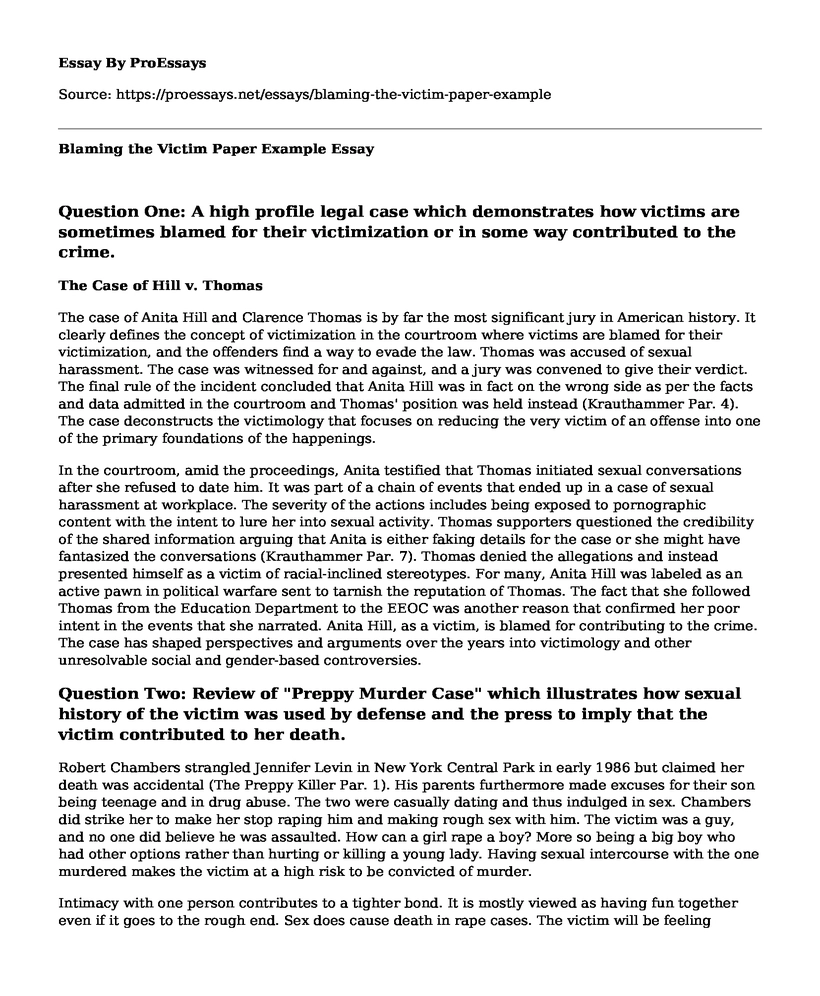Question One: A high profile legal case which demonstrates how victims are sometimes blamed for their victimization or in some way contributed to the crime.
The Case of Hill v. Thomas
The case of Anita Hill and Clarence Thomas is by far the most significant jury in American history. It clearly defines the concept of victimization in the courtroom where victims are blamed for their victimization, and the offenders find a way to evade the law. Thomas was accused of sexual harassment. The case was witnessed for and against, and a jury was convened to give their verdict. The final rule of the incident concluded that Anita Hill was in fact on the wrong side as per the facts and data admitted in the courtroom and Thomas' position was held instead (Krauthammer Par. 4). The case deconstructs the victimology that focuses on reducing the very victim of an offense into one of the primary foundations of the happenings.
In the courtroom, amid the proceedings, Anita testified that Thomas initiated sexual conversations after she refused to date him. It was part of a chain of events that ended up in a case of sexual harassment at workplace. The severity of the actions includes being exposed to pornographic content with the intent to lure her into sexual activity. Thomas supporters questioned the credibility of the shared information arguing that Anita is either faking details for the case or she might have fantasized the conversations (Krauthammer Par. 7). Thomas denied the allegations and instead presented himself as a victim of racial-inclined stereotypes. For many, Anita Hill was labeled as an active pawn in political warfare sent to tarnish the reputation of Thomas. The fact that she followed Thomas from the Education Department to the EEOC was another reason that confirmed her poor intent in the events that she narrated. Anita Hill, as a victim, is blamed for contributing to the crime. The case has shaped perspectives and arguments over the years into victimology and other unresolvable social and gender-based controversies.
Question Two: Review of "Preppy Murder Case" which illustrates how sexual history of the victim was used by defense and the press to imply that the victim contributed to her death.
Robert Chambers strangled Jennifer Levin in New York Central Park in early 1986 but claimed her death was accidental (The Preppy Killer Par. 1). His parents furthermore made excuses for their son being teenage and in drug abuse. The two were casually dating and thus indulged in sex. Chambers did strike her to make her stop raping him and making rough sex with him. The victim was a guy, and no one did believe he was assaulted. How can a girl rape a boy? More so being a big boy who had other options rather than hurting or killing a young lady. Having sexual intercourse with the one murdered makes the victim at a high risk to be convicted of murder.
Intimacy with one person contributes to a tighter bond. It is mostly viewed as having fun together even if it goes to the rough end. Sex does cause death in rape cases. The victim will be feeling offended since the other party is doing it against his wish. However, it can be solved by other means like pushing away or screaming to make him stop. If not, using too much force is thus branded as a crime against the offender. Force may result in death or chronic injury. These are crimes contributed by the victim which often are filed. It is assumed that maybe the victim did want to end the offender life willingly and not by mistake. Jealousy could be one of the reasons argued by scholars. In Chambers case, no one believed he did not mean to kill Levin, but it was claimed to be a self-driven action.
Works Cited
"The Preppy Killer." CBS News, CBS Interactive, www.cbsnews.com/news/robert-chambers-jennifer-levin-murder-the-preppy-killer/.
Krauthammer, Charles. "The Case of Hill V. Thomas." The Washington Post, WP Company, 18 Oct. 1991, www.washingtonpost.com/archive/opinions/1991/10/18/the-case-of-hill-v-thomas/01ecd59e-9161-4562-8498-4f0e88a1c49b/?noredirect=on&utm_term=.84745a9529d5.
Cite this page
Blaming the Victim Paper Example. (2022, Jun 19). Retrieved from https://proessays.net/essays/blaming-the-victim-paper-example
If you are the original author of this essay and no longer wish to have it published on the ProEssays website, please click below to request its removal:
- On the Duty of Civil Disobedience - Essay Analysis
- Intel Corp. v Commission Case Study
- Witness Interview, Statement and Interview Analysis Paper Example
- Annotated Bibliography: How Domestic Violence Affects Immigrants in the Hispanic Community in the United States?
- Discrimination and Prejudice Against the Mentally Ill People - Research Paper
- Distinguishing Factors of Sexual Offenses: Rape, Child Molestation, Exhibitionism, Sex Trafficking - Essay Sample
- Free Report Example: Evaluating Long-Term Effects of Prisoner Re-Entry Services on Recidivism







